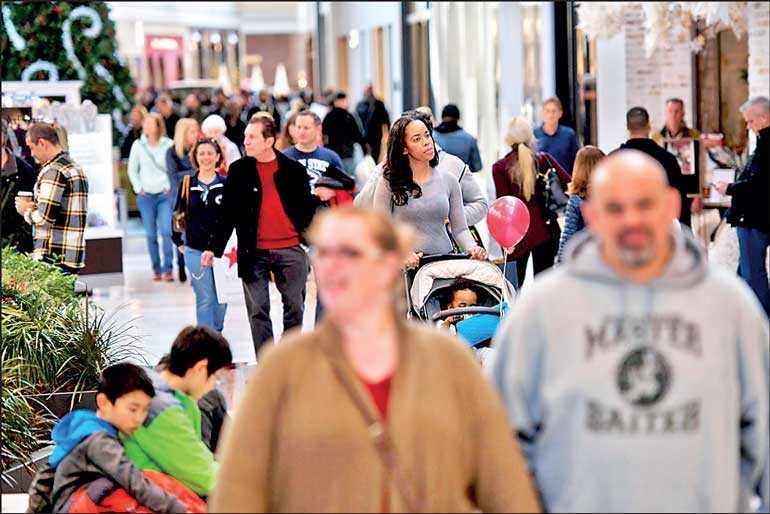Friday Dec 19, 2025
Friday Dec 19, 2025
Thursday, 30 May 2019 00:00 - - {{hitsCtrl.values.hits}}

WASHINGTON (Reuters): Consumer confidence jumped in May as households grew more upbeat about the labour market, suggesting the economy remained on solid ground despite signs that activity was slowing after being temporarily boosted by exports and a build-up of inventories.
The surge in confidence reported by the Conference Board on Tuesday came despite an escalation in tensions in the 10-month trade war between the United States and China, which sparked a sharp sell-off on Wall Street. It mirrors strength exhibited by another sentiment surveys in the middle of this month.
Economists said the strong readings likely did not fully capture the impact of the trade standoff between Washington and Beijing. The cut-off date for the Conference Board survey was on 16 May. The US raised existing tariffs on $200 billion in Chinese goods to 25% from 10% on 10 May, prompting Beijing to retaliate with its own levies on American imports.
“So there was at least some time for the recent escalation in the trade spat with China to factor in,” said Tim Quinlan, a senior economist at Wells Fargo Securities in Charlotte, North Carolina. “But at this stage, consumers are nonplussed.”
The Conference Board said its index of consumer attitudes increased 4.9 points to a reading of 134.1 this month, climbing up to levels seen last November when the index was hovering near 18-year highs. Economists polled by Reuters had forecast the index rising to 130.0 this month.
The survey’s expectations index, based on consumers’ short-term outlook for income, business and labour market conditions, increased to a reading of 106.6 this month from 102.7 in April.
The Conference Board survey’s so-called labour market differential, derived from data on respondents’ views on whether jobs are plentiful or hard to get, increased to 36.3% from 33.2% in April. That measure closely correlates to the unemployment rate in the Labour Department’s employment report.
The labour market is tight, with the unemployment rate at 3.6%, a level last seen almost 50 years ago.
While the sentiment surveys have been upbeat, the so-called hard economic data have weakened in recent months. Industrial production, durable goods orders, retail and home sales fell in April, suggesting the economy lost considerable momentum early in the second quarter after getting a lift from exports and an accumulation of unsold goods in warehouses in the first quarter.
The Atlanta Federal Reserve is forecasting gross domestic product increasing at a 1.3% annualized rate in the second quarter. The economy grew at a 3.2% pace in the January-March quarter. Growth is mostly slowing as last year’s massive stimulus from the Trump administration’s tax cuts and spending increases fades.
The dollar was trading higher on Tuesday. US Treasury prices rose, with the yield on the benchmark 10-year note dropping to its lowest level since October 2017. Stocks on Wall Street eked out modest gains.
House prices slowing
“As long as job growth is strong, that is the green light we need to keep consumers moving along,” said Jennifer Lee, a senior economist at BMO Capital Markets in Toronto.
Consumers anticipated inflation would remain muted over the next 12 months. The survey’s one-year inflation expectations fell to 4.4% in May from 4.6% in April.
Inflation has been benign despite the tight labour market, prompting calls from President Donald Trump for the Federal Reserve to cut interest rates. The US central bank recently suspended its three-year interest rate hiking campaign and last month showed little desire to alter its monetary policy stance.
Other data on Tuesday showed a further moderation in house price inflation, which could help support the struggling housing market. But a chronic shortage of lower-priced homes remains an obstacle amid strong demand that has been stoked by declining mortgage rates.
The S&P CoreLogic Case-Shiller composite index of home prices in 20 metropolitan areas increased 2.7% in the 12 months to March after rising 3.0% the prior month. In another report the Federal Housing Finance Agency (FHFA) said its house price index rose a seasonally adjusted 4.9% in March from a year ago. That followed a 5.1% gain in February.
The FHFA’s index is calculated by using purchase prices of houses financed with mortgages sold to or guaranteed by mortgage finance companies Fannie Mae and Freddie Mac.
“A variety of different measures of housing activity have been soft in recent months despite the recent decline in mortgage rates and if affordability issues are weighing on the housing market, house prices could continue to soften moving forward,” said Daniel Silver, an economist at JPMorgan in New York.